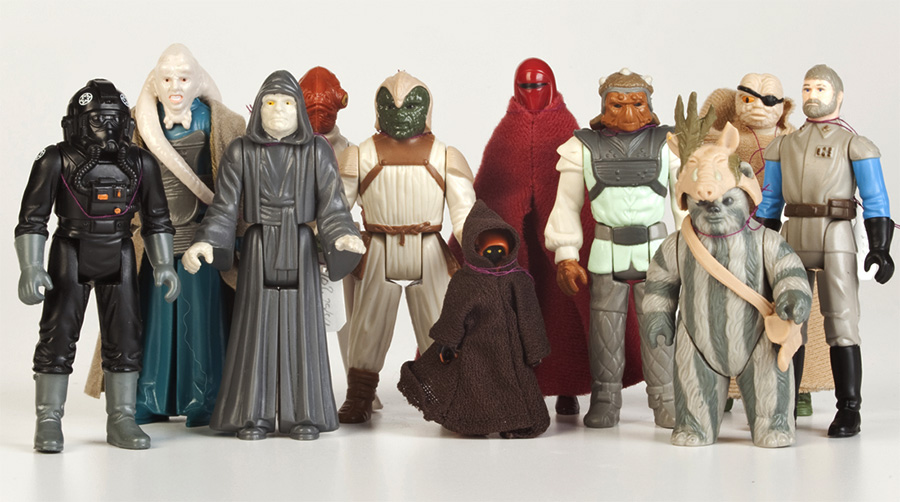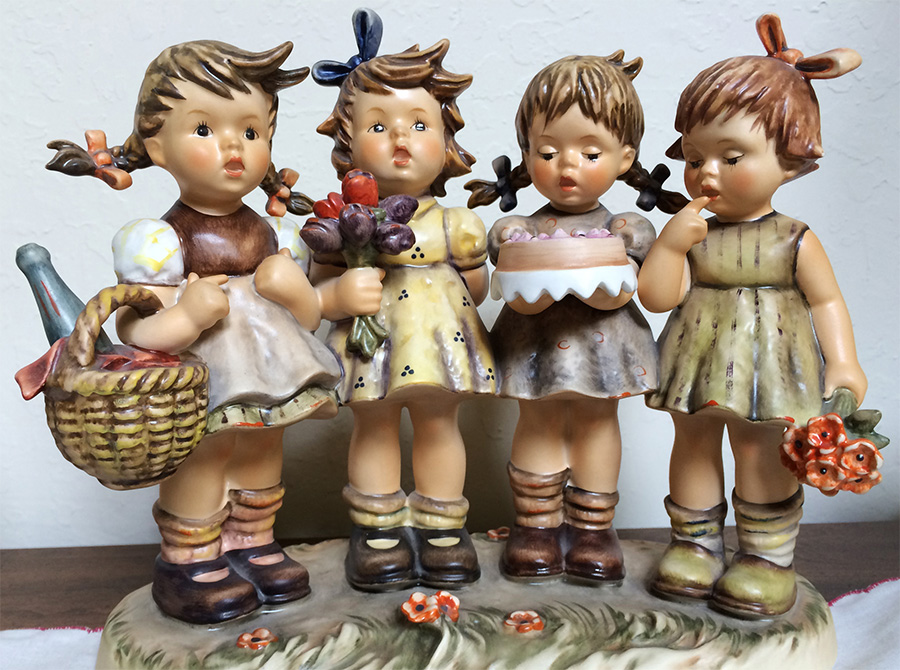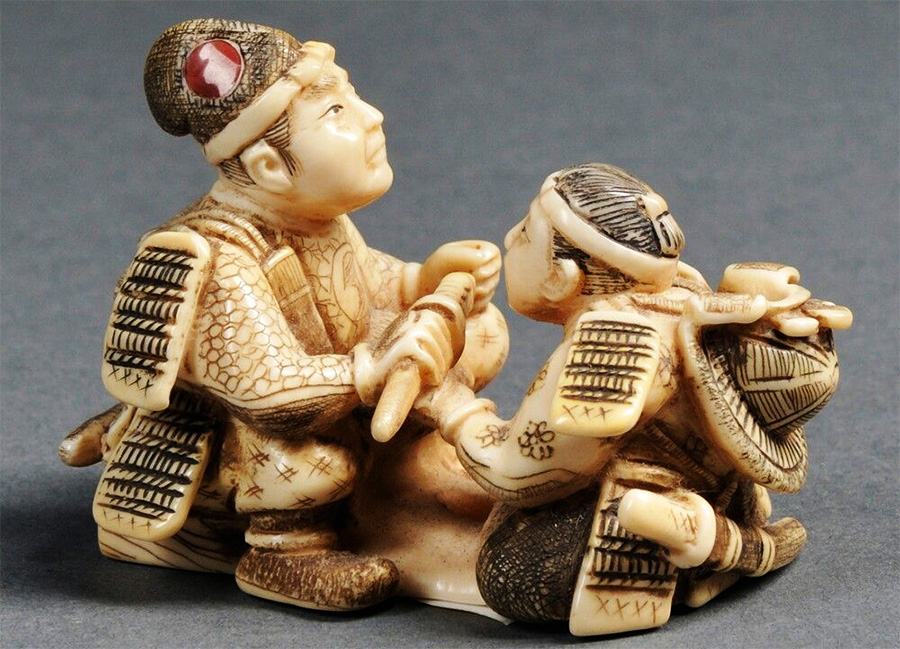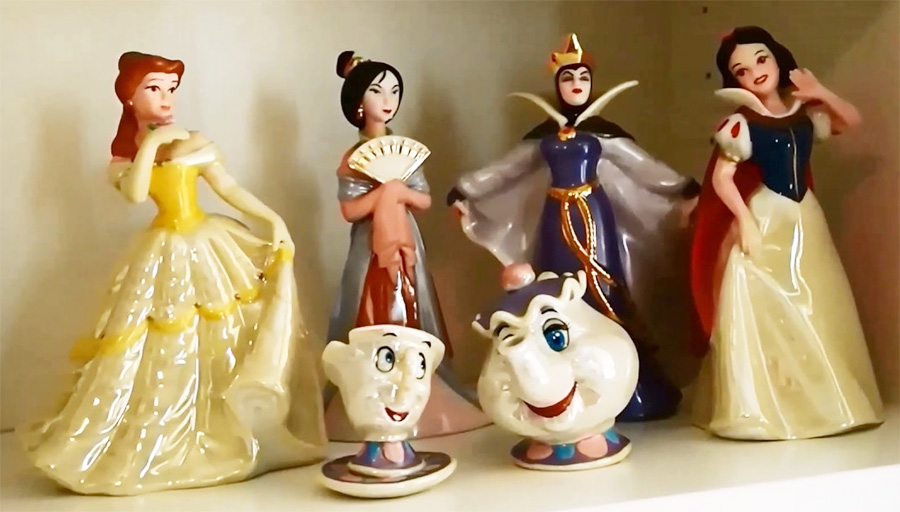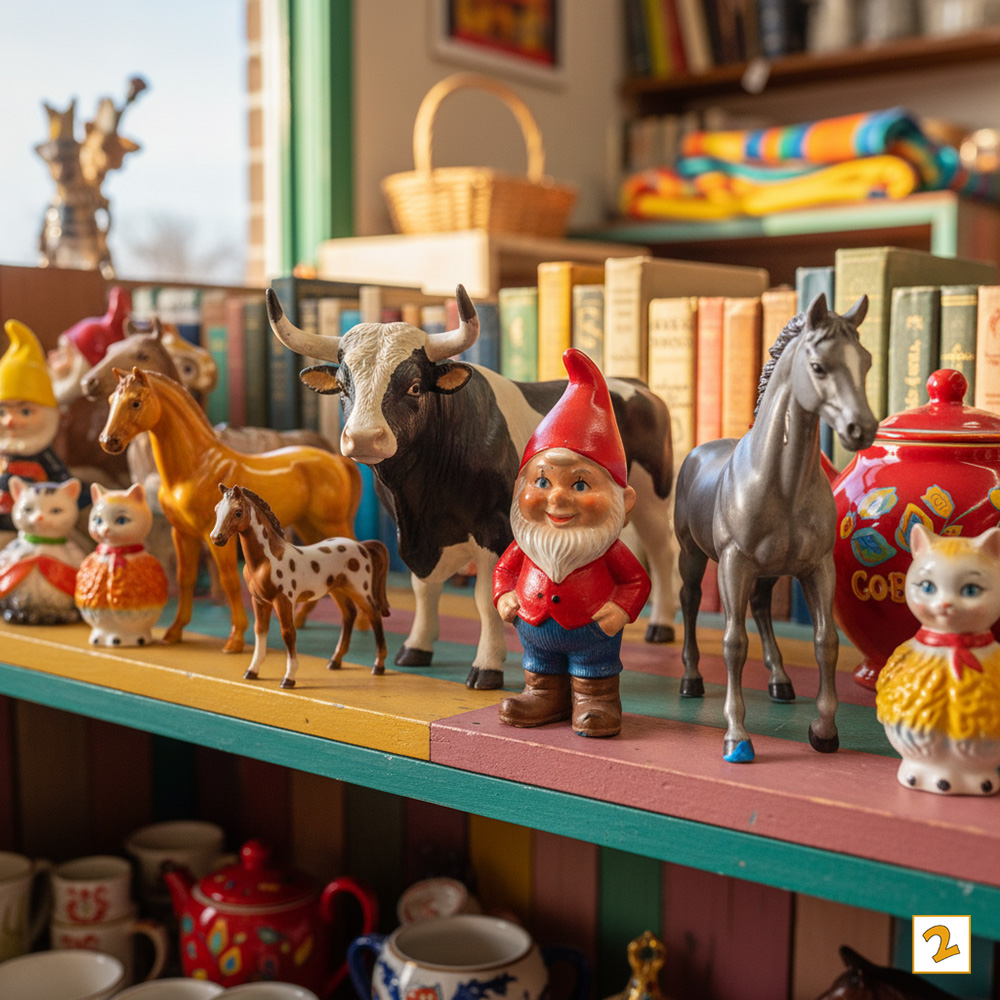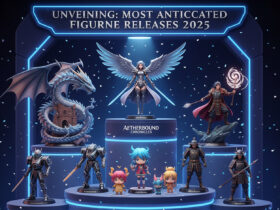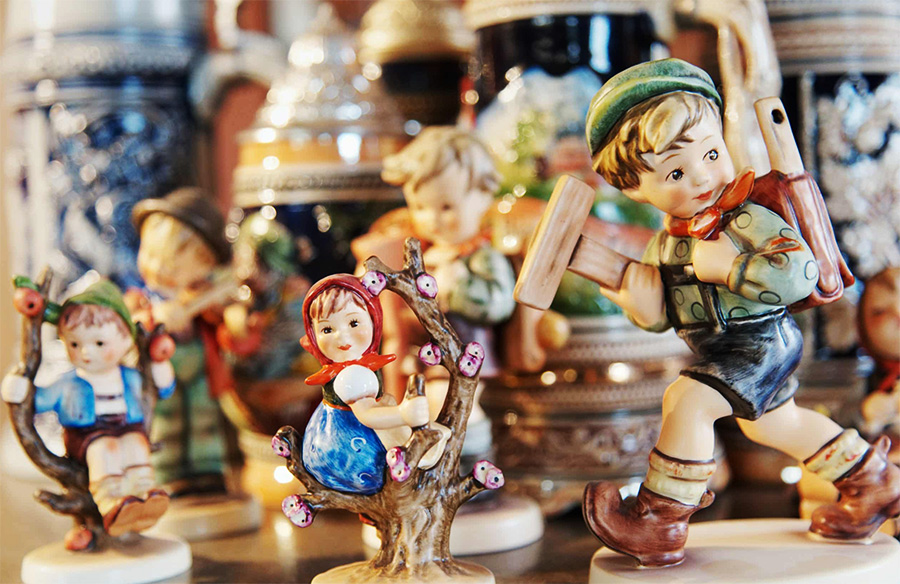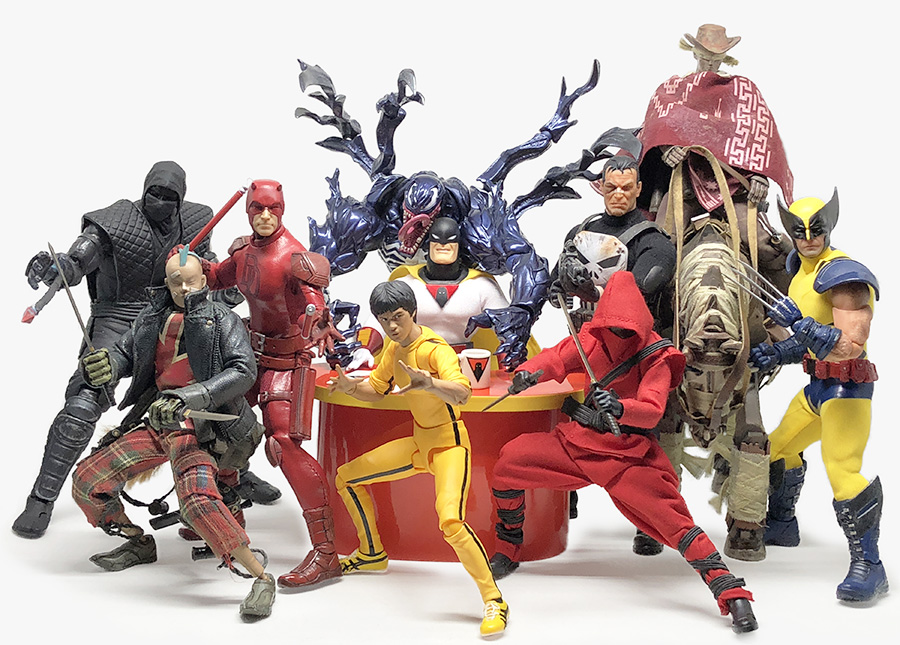You know the sound.
It’s the clinking, high-pitched tink-tink-tink of porcelain on porcelain as you push aside another dozen identical ceramic cats. You’re in the “housewares” aisle of your local thrift store, a place where figurines go to die. The shelves are a graveyard of 1980s kitsch: pastel-colored geese with blue ribbons, sad-eyed clowns, and an army of Victorian-style ladies holding parasols.
It’s so easy to get “shelf blindness.” Your eyes glaze over, and you just walk away. And that, my friend, is the biggest mistake a treasure hunter can make.
Let’s be real. Most of that stuff is, in fact, junk. But hiding in plain sight—often priced at $1.99 right next to a worthless “Made in China” import—are legitimate treasures. We’re not talking about the ultra-obvious, holy-grail brands that even the store’s sorters know to look for, like Meissen or Herend. The real money, the thrill of the flip, is in finding the “B-list” brands. The ones that are 90% kitsch, but 10% pure gold. The ones that other flippers ignore because they don’t know the secret.
Today, we’re sharing the secret. This is your treasure map. Here are five surprising, often-overlooked animal figurine brands that can be worth serious money.
1. Beswick (England)
The Brand You’re Ignoring: When people do recognize the Beswick name, they immediately think of the twee, adorable Beatrix Potter characters—Jemima Puddle-Duck, Peter Rabbit, and the rest. And yes, those are collectible. But they are also common, and their value is modest unless you find a very early or rare one.
The real secret to Beswick is everything else.
Founded in 1894 in Longton, Stoke-on-Trent, England, Beswick built its reputation on creating some of the most realistic and anatomically correct animal figurines ever produced. They hired master sculptors like Arthur Gredington and Albert Hallam, who didn’t just make a “horse,” they made a specific, champion-winning thoroughbred or a prize-winning Charolais bull.
Why It’s Valuable: Quality and niche appeal. Beswick’s “Champion Animal” series is legendary among breed-specific collectors. A person who raises Highland cattle doesn’t just want a generic cow figurine; they want the Beswick Highland Bull (Model 2008), and they will pay hundreds for it. The realism is unmatched. The glazes are deep, complex, and beautiful.
The company was purchased by Royal Doulton in 1969, and production of the classic animal models largely ceased by the 1990s. This finite run, combined with rabid collector demand, has made key pieces skyrocket in value.
What to Look For (The Hunter’s Guide):
- The “Money” Models:
- Horses: This is Beswick’s bread and butter. Look for realistic horses in unusual, rare “colorways.” For example, a common “Shire Mare” (Model 818) in brown gloss might sell for $40. The exact same mold in a rare “Piebald” (black and white) or “Skewbald” (brown and white) finish can sell for $300 to $600. Look for famous racehorses (like Red Rum) and wild “decorator” colors.
- Cattle: This is the ultimate sleeper category. The breed-specific bull and cow models are hot. The aforementioned Charolais Bull (Model 1363A) is a grail piece, often selling for $1,000 to $2,000. Other valuable models include the Hereford Bull, Aberdeen Angus, and the picturesque Highland cattle.
- Dogs: Large, realistic models of popular breeds (like German Shepherds, Collies, and Boxers) are always good sellers ($50-$150). Rare colorways, again, are king.
- The Marks: This is how you date your find.
- “Beswick England” (Circular Mark): Found on pieces from 1936-1954. This is a great, early mark to find.
- “Beswick England” (Script Mark): A simple, impressed script. Also an early and desirable mark.
- Gold “Beswick” Script (1969-1989): This is a “Doulton-era” mark. These are generally less valuable than the pre-1969 pieces but are still collectible.
- No “England”: If it just says “Beswick” with a model number, it might be a later or non-animal piece. Always look for the “England.”
Value Check:
- Common Find (Beatrix Potter): $15 – $30
- Good Find (Common Horse/Dog): $40 – $75
- Holy Grail (Rare Colorway Horse, Charolais Bull): $500 – $2,000+
2. Goebel (West Germany)
The Brand You’re Ignoring: Walk past any collectibles shelf, and you’ll see a dozen Goebel-marked items. 99% of the time, they are M.I. Hummel figurines. And here’s the hard truth your grandmother doesn’t want to hear: the Hummel market has almost completely collapsed. What were once $200 prized collectibles now languish in thrift stores for $5.
Because of this, flippers see the “Goebel” name and associate it with “no value.” This is a critical error.
Goebel was the parent company, a massive porcelain firm in West Germany. Hummels were just one product line. For decades, they also produced thousands of other items, including some of the most high-quality, expressive, and charming animal figurines on the market. While everyone is hunting for Hummels (or avoiding them), they are leaving behind the real Goebel money-makers.
Why It’s Valuable: Quality and crossover appeal. Goebel’s realistic animals, especially their dogs, cats, and wildlife, are superb. They have a weight and a quality of artistry that feels different from cheap imports. They also produced whimsical “anthropomorphic” lines that have a huge cult following.
What to Look For (The Hunter’s Guide):
- The “Money” Models:
- Realistic Animals: Look for any beautifully crafted animal, especially dogs (poodles, dachshunds, terriers were popular), birds, and woodland creatures (foxes, deer, squirrels). These are steady sellers in the $25 – $60 range.
- “Co-Boys” Gnomes: These are the real prize. Before “David the Gnome” or garden gnomes were a thing, Goebel made a line of whimsical, sometimes grumpy-looking gnomes in the 1950s-70s. They are often marked with “Co-Boy” and a model number. These are insanely popular and can sell for $75 to $200 each.
- Friar Tuck: A kitschy but beloved line of chubby monk figures (Friar Tuck) shown as pitchers, mugs, and salt shakers. A full set can be surprisingly valuable.
- Disney: Goebel held an early license for Disney characters. Any Goebel-marked Disney piece (Mickey, Donald, etc.) from the 50s or 60s is an instant “buy.”
- The Marks: Dating Goebel is all about the “Bee.” The mark evolved over the decades, and this is crucial for value.
- The “Crown” Mark (1935-1949): The earliest mark. Finding this on a non-Hummel animal is rare and valuable.
- The “Full Bee” (TMK-2, 1950-1959): This is the mark to memorize. It features a large, detailed bee flying inside a “V.” This is the “boomer” era of peak quality. A piece with a Full Bee mark is always worth a second look and commands a premium.
- The “Stylized Bee” (TMK-3, 4, 5): From the 1960s to the 1970s, the bee became more of a simple, stylized logo. These are still high-quality “West Germany” pieces and very desirable.
- The “Goebel” Name (TMK-6, 7, 8): From 1979-present, the bee logo was removed, and the mark just says “Goebel” or “Goebel Germany.” These are less valuable but can still be good flips if the subject matter is desirable.
Value Check:
- Common Find (Hummel Figurine): $5 – $10
- Good Find (Realistic Dog, Stylized Bee): $30 – $60
- Holy Grail (“Full Bee” Disney, Rare “Co-Boy” Gnome): $150 – $300+
3. Hagen-Renaker (USA)
The Brand You’re Ignoring: This is the ultimate “thrifter’s secret.” You have seen, touched, and ignored hundreds of these.
Hagen-Renaker figurines are those tiny (often 1-2 inch) ceramic animals, usually horses, dogs, or woodland creatures, that you see jumbled in tag-sale boxes or sitting in the thrift store’s “smalls” case for 50 cents. They look and feel like gift-shop doodads. How could they possibly be valuable?
Here’s the secret: Hagen-Renaker, a California-based company, has been making these miniatures since the 1940s. Their early artists were brilliant, and the company’s complex history is full of limited runs, test models, and short-lived product lines that are now holy grails for a massive, obsessive collector base.
Why It’s Valuable: Extreme rarity and crossover markets. The company’s most valuable pieces fall into two categories:
- Disney (1950s): Hagen-Renaker produced some of the first-ever 3D figurines for Walt Disney’s Bambi, Fantasia, Lady and the Tramp, and Peter Pan. These were only made for a few years (1955-1960) and are legendarily rare. A complete set of the Lady and the Tramp figures (Lady, Tramp, Scamp, etc.) can sell for over $2,000.
- Pedigree Line: Before they focused on miniatures, Hagen-Renaker produced a line of large-scale (8-12 inch) “Pedigree” animals, mostly champion dogs and horses. These were made in the 1950s and are exceptionally rare and valuable.
What to Look For (The Hunter’s Guide):
- The “Money” Models:
- ANY Early Disney: This is a “drop everything and buy it” moment. Look for characters from Bambi (Thumper, Flower), Fantasia (the baby Pegasus, unicorns), and Lady and the Tramp (Jock, Trusty, Si & Am). Even a single one of these “paper label” figures can fetch $100 to $400.
- Large “Pedigree” Figures: You’ll most likely find these separated from their miniature cousins. They are larger, heavier, and marked on the bottom. A single Pedigree dog (like the Collie or Cocker Spaniel) can sell for $300 to $800.
- Rare Miniatures: Even in the tiny sizes, rarity is key. Look for horses with complex “Appaloosa” spot patterns, rare colors, or discontinued molds. A 3-inch “Running Stallion” in a common bay color is worth $15. A rare “Stardust” (blue with gold spots) version sold for over $1,000.
- The Marks: This is the hard part, as marks are inconsistent.
- Foil or Paper Labels: The earliest and most valuable pieces (1940s-1950s) had paper or foil stickers. These are almost always gone, having been washed or peeled off. You have to learn to identify the style of the figurine—the high-gloss glaze, the specific mold, and the “look” of the piece. This is where you have to do your homework.
- “H-R” Incised Mark: Later pieces (1970s-present) sometimes have a small “H-R” or “HR” scratched or stamped into the ceramic.
- No Mark: Most miniatures you find will have no mark at all. Your only guide is the distinctive style, glaze, and mold. Start by searching “Hagen-Renaker horse” on eBay and just scrolling. You will quickly train your eye to spot them.
Value Check:
- Common Find (Modern Miniature Horse/Cat): $5 – $10
- Good Find (Discontinued Miniature, “H-R” Mark): $30 – $75
- Holy Grail (Early Disney Figurine, Large Pedigree Dog): $200 – $2,000+
4. Breyer (USA)
The Brand You’re Ignoring: “But wait,” you say, “Breyer horses are plastic toys!” Precisely. And every thrift store has a 50-gallon tub of them in the toy section, scratched, yellowed, and missing legs, priced at 25 cents apiece.
And that’s why no one bothers to look.
Breyer, which started making plastic horses in 1950, is a massive collectible field. 99% of what you find is worthless, played-with junk. But that 1%… that 1% is one of the most profitable flips in the reselling world. This is a game of “insider knowledge.” You are hunting for rare variations of the exact same toy that everyone else is throwing back in the bin.
Why It’s Valuable: Collector mania, plain and simple. Breyer collectors are like coin or stamp collectors: they obsess over tiny variations. They will pay four figures for a model that was painted a slightly different way, had a different finish, or was made from a different plastic for a single year.
What to Look For (The Hunter’s Guide):
- The “Money” Models:
- “Woodgrains” (1950s-1960s): The earliest models weren’t painted realistically. They were given a hand-painted, swirling faux-woodgrain finish. These are extremely rare and desirable. Finding any Breyer model with a woodgrain finish, even in poor condition, is a $100+ score. A good one can be $1,000+.
- “Chalkies” (1973-1975): During the 1970s oil crisis, Breyer’s white plastic supplier ran short. For a couple of years, they molded horses out of whatever color plastic they could get (blue, green, yellow, pink) and then covered it with a thick white “base coat” before painting the final color. These are “Chalkies.”
- How to Spot: Look for rubs and scratches, especially on the ear tips, muzzle, and hoof bottoms. If you see a bright, non-white color peeking through, you have found a Chalky. A common $10 horse mold becomes a $150 – $400 Chalky.
- “Decorators” (1960s): The most bizarre and valuable of all. In the 60s, Breyer released a line of models in “decorator” colors that no horse has ever been: “Wedgewood” (blue and white), “Kopenhagen” (blue filigree), “Gold Charm,” and “Florentine” (gold-flecked). They were a massive flop. Stores couldn’t give them away. Because they sold so poorly, they are now the rarest and most sought-after Breyers ever made, selling for $2,000 to $10,000.
- The Marks:
- All early Breyers have an impressed “Breyer Molding Co.” or “Breyer” stamp, usually on the inside of a back leg or on the belly.
- Don’t worry about the mark. Worry about the finish. Is it glossy? Is it woodgrain? Is it a “Chalky”? That’s where the money is.
Value Check:
- Common Find (Scratched Bay Horse, 1980s-Present): $0.25 – $2.00
- Good Find (Modern “Special Run” in Good Condition): $25 – $50
- Holy Grail (“Woodgrain,” “Chalky,” or “Decorator” Model): $200 – $10,000
5. Lefton (Japan)
The Brand You’re Ignoring: This one might be the most surprising of all, because 95% of Lefton products are the definition of low-value, mid-century kitsch.
If you’ve spent any time in a thrift store, you’ve seen the “Lefton China” mark, usually a red foil sticker or a green ink stamp. It’s on countless birthday-of-the-month angels, porcelain ladies in poofy dresses, delicate floral teacups, and little planters shaped like birds or baby booties. Most of it is worth $5-$10, max.
So why is it on this list? Because specific, niche Lefton lines have developed a fanatical following, and their prices have exploded. People associate “Lefton” with “cheap,” so they don’t even bother to look up the specific piece.
Why It’s Valuable: Nostalgia and “crossover” appeal. Collectors of “kitsch” or specific themes (like anthropomorphic animals, cats, or vintage Christmas) have zeroed in on certain Lefton lines, driving prices to absurd levels. These collectors aren’t buying it because it’s “fine porcelain”; they’re buying it because it’s the exact rare “Bluebird” teapot they need to finish their set.
What to Look For (The Hunter’s Guide):
- The “Money” Models:
- “Bluebirds” Line (1950s): This is the big one. An entire line of kitchenware (teapots, cookie jars, shakers, jam jars) featuring a cute, anthropomorphic bluebird family. They are all valuable. The Bluebird Cookie Jar can sell for $200 – $350. The teapot, $150 – $250. Even the little jam jar can fetch $75.
- “Miss Priss” (Cat): An anthropomorphic white cat line, also on kitchenware. The Miss Priss Cookie Jar is another $150 – $300 piece.
- Rare Cookie Jars: Lefton made hundreds of cookie jars. Most are worthless, but the rare, desirable ones (like “Dutch Girl,” “Apple Head,” or the “Sassy Cat”) are all $100+ items.
- “Spaghetti” Animals: Some Lefton animals (especially poodles and cats) were decorated with “spaghetti” porcelain trim. If they are large and in perfect condition, these have a strong following.
- Vintage Christmas: Certain Christmas pieces, like the “Holly” line of teapots and shakers, or large, rare Santa figurines, command high prices from holiday collectors.
- The Marks:
- Red & Gold Foil Label: The most common mark. It just says “Lefton’s” or “Lefton’s Exclusives Japan.” The presence of the sticker is nice, but it’s the piece that matters.
- Ink Stamps: You will often see a green or blue stamp that says “Lefton China, Hand Painted” with a crown logo.
- Model Numbers: Most Lefton pieces have an impressed or stamped model number (e.g., “GEO Z. LEFTON” or just a number like “H888”). This is your key. If you find a piece that looks like it might be something, like a cat cookie jar, Google “Lefton cat cookie jar” and see if you can match the model number. That’s how you tell the $10 jar from the $200 “Miss Priss.”
Value Check:
- Common Find (Birthday Angel, Small Planter): $3 – $10
- Good Find (“Spaghetti” Poodle, “Holly” Shakers): $25 – $50
- Holy Grail (“Bluebird” Cookie Jar, “Miss Priss” Teapot): $150 – $350+
Your New Mission: A Quick Guide to Hunting
Remember, finding these isn’t just about spotting the brand. It’s about spotting the opportunity. Your new mission, should you choose to accept it, involves a new set of skills:
- Check Every Animal: Don’t just scan for the “look” of high-end porcelain. Pick up the kitschy stuff. Pick up the tiny stuff. Pick up the plastic stuff.
- Learn the Marks: Memorize the Goebel “Full Bee” and the Beswick “England” marks. They are your fastest indicators of quality.
- Inspect for Damage: This is the part that makes or breaks a flip. Run your finger gently around every rim, ear tip, and tail. Any tiny chip, hairline crack, or “flea bite” can cut the value in half. Check for “crazing” (a spider-web of cracks in the glaze). On high-value items, check for repairs. Does the paint quite match? Is there a faint glue line?
- When in Doubt, Look it Up: You have a supercomputer in your pocket. See a weird Goebel gnome? Google “Goebel Co-Boy.” Find a Breyer with blue plastic under a chip? Google “Breyer Chalky.” The answers are right there.
The shelves are not picked clean. The thrift stores are not out of treasure. The game has just changed. The people who make real money aren’t the ones finding the obvious, 24-karat-gold-plated trophy. They’re the ones with the knowledge to pull a 50-cent, 2-inch ceramic mouse out of a junk bin, knowing it’s a $200 Hagen-Renaker Disney piece.
The treasure is there. It’s just waiting for someone who knows how to see it.

